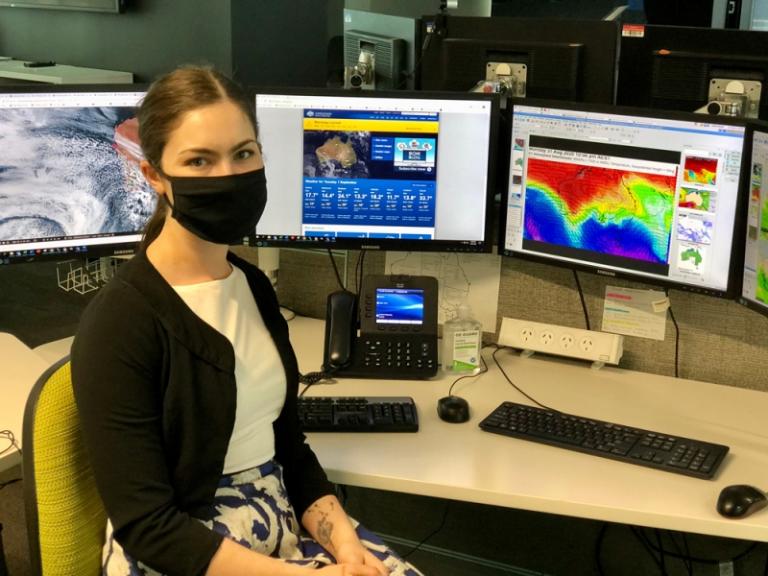Surge in demand
The Australian Government’s support measures for COVID-19 announced in March-April 2020 were significant: $289 billion in fiscal and balance sheet measures, equivalent to around 14.6% of GDP.[18]
Following national restrictions implemented by National Cabinet on 22 March, more than 1 million Australians found themselves out of work and seeking immediate assistance from the Government.[19] The sudden closure of businesses left many in the community without paid work. Approximately half of Australian businesses surveyed in March reported an adverse impact as a result of COVID-19 and 86% of businesses anticipated being impacted in the months ahead.[20]
During March the Government announced early release of superannuation for individuals in financial stress and the JobKeeper payment to keep people connected to their jobs, prompting a surge in demand for government payments.[21]
By 8 May the ATO had approved 1.3 million applications for early release of superannuation; a total of $10.6 billion.[22] By mid-July, 960,000 organisations and more than 3.5 million individuals had received JobKeeper payments worth $30.6 billion with an estimated total spend through to 2020-21 of $85.7 billion.[23] The Boosting Cash Flow for Employers measure provided more than $16 billion in payments to more than 750,000 employers across Australia.[24]
Public facing services increased to levels unseen before.
Services Australia processed 1.3 million JobSeeker claims in 55 days, a claim volume normally processed in 2.5 years. At the peak, more than 53,000 claims were completed in a single day. Within the same period, Services Australia monitored:
- 3.7 million phone calls
- 1.9 million service centre walk-ins
- 250,000 social media interactions.[25]
In the ATO, call volumes increased by 106% in April 2020, compared to April 2019.[26]
See also: Kathryn Campbell AO CSC speaking on the IPAA Work with Purpose podcast series.
The surge in demand was not limited to JobSeeker and JobKeeper; almost every APS agency faced significant increases in demand for some, or all, of its functions.
Call centres, communication, media and digital teams; as well as internal enabling functions such as facilities and ICT all experienced rising demand.
In mid-March, the Department of Health’s AskMBS function which assists health practitioners to comply with Medicare Benefits Schedule billing requirements, saw the number of enquiries received more than double, compared to pre-COVID levels.
The number of businesses contacting the Department of Industry, Science, Energy and Resources between March to June 2020 increased by 116% compared to the same period in 2019, and variations to business grants increased by almost 150%.[27]
The myGov website, which hosts digital access to Centrelink, Medicare and ATO services, received 2.6 million logins on 25 March 2020. This was a 44% increase on the previous record of 1.8 million daily logins, recorded during the July 2019 tax time period.[28]
There was also an increased demand for up-to-the-minute information.
Statistical releases from the ABS increased by more than 51% in May and June 2020 compared to the average for the previous 13 months.
The Department of Health’s social media team had over a 3,000% increase on business-as-usual social media activity between 20 January and 29 May 2020. Traditional media enquiries also increased for agencies; the ABS received approximately 67% more media enquiries in June 2020 than June 2019.[29]
Many policy teams experienced significant increases in their work to develop advice and policies to assist with the COVID-19 response.
For example, the Attorney-General’s Department supported the development and implementation of the temporary JobKeeper amendments to the Fair Work Act 2009, and developed legislation to provide privacy protections to users of the COVIDSafe app.[30] The introduction of JobKeeper, new measures to assist businesses, and changes to JobSeeker all required significant work from policy teams and agencies to reach decision and implementation. Services Australia implemented 50 policy changes to 20 payments on behalf of numerous departments in just 55 days. The agency added almost 300 new services to the Medicare Benefits Schedule, often within hours of a Government decision.[31]
Available data shows ministerial submissions, briefing and correspondence to Government almost doubled in March, tripled in April and June, and quadrupled in May to more than 15,000 across 7 agencies (Figure 1.2).
Figure 1.2: Volume of Parliamentary Document Management System (PDMS) outputs, 7 agencies (June 2019 and March to June 2020)

Source: Internal agency PDMS data
Internationally, employees from the Department of Foreign Affairs and Trade (DFAT) worked around the clock to assist more than 28,000 Australians to return from overseas.[32] During this time, DFAT has also provided consular support to Australians overseas in quarantine or diagnosed with COVID-19, receiving more than 40,600 phone calls to its consular service.[33]
Since 21 January DFAT has updated more than 2,300 travel advisories; shared around 5,300 Smartraveller social media posts; and fielded over 90,000 COVID-19 related phone calls. This was done while transitioning around 300 DFAT portfolio employees and 800 dependants out of diplomatic posts on welfare, medical and safety grounds. DFAT has since supported the progressive return of employees and dependants to diplomatic posts following an assessment of the risks in each location and appropriate mitigations.[34]
Within Australia and across the globe, these actions speak volumes. Each phone call or claim represents an individual or business owner in acute need of assistance, and an APS employee connecting them to essential services and support.
APS support for Australians

Case study: A rapid response in-flight

Aviation was one of the first industries impacted by the COVID-19 pandemic, and it continues to be one of the hardest-hit of Australia’s major industries.
Over 4 weeks, travel restrictions, social distancing, quarantine requirements, business closures, and stay-at-home orders effectively shut down air travel.
At its lowest point, domestic passenger numbers fell from over 1 million to around 30,000 per week (down over 97%); from 13,000 weekly flights to 600 weekly flights; and from 1.6 million weekly available seats to 60,000 weekly available seats.
In response, the Department of Infrastructure, Transport, Regional Development and Communications rapidly designed and implemented a series of interrelated funding programs and measures designed to stabilise the sector. Across government $2.7 billion has been committed to the aviation sector, with these measures ensuring the continued delivery of minimum levels of aviation connectivity (for freight and people) during the pandemic, and the preservation of industry capacity and capability for the recovery phase.
A new dedicated Aviation and Airports Group (AAG), comprising 7 branches working together across 2 linked divisions is now in place. Using a taskforce model, it features high levels of mobility and agility to respond to the rapidly changing environment.
Approximately 40 additional employees (including 5 additional SES officers) all with a range of policy and program skills joined existing subject matter experts.
Within AAG, flat and fluid organisational structures were adopted to enable:
- stable levels of continuity for new programs: to provide stakeholders with meaningful and known contacts within the department during a time of crisis
- probity and integrity of program design and delivery: an early and ongoing focus on governance, including the standing up of a new assurance function and dedicated Program Delivery Board within AAG
- business as usual work to continue: to ensure high levels of visibility and agreement around trade-offs being made in terms of temporarily pausing lower priority work and ongoing attention to all legislated functions
- new dedicated tiger teams for rapid deployment: to provide an essential, highly mobile policy response capability in a highly volatile environment.
At the height of the pandemic response work approximately 90% of the 120 staff in the AAG were working on COVID-19 issues. AAG’s work was achieved through the ongoing professionalism and diligence of individual officers and resourcing and specialist support from across the department.
The success of the response is evidenced by the timely, robust implementation of measures which have ultimately allowed the aviation sector to continue operations during the crisis phase and position it for the recovery phase.
Case study: Delivery of essential weather services come rain, bushfire, or global pandemic

Caption: Diana Eadie, a Communication Meteorologist, on the job during Stage 4 in Melbourne, delivering essential services for Australia.
During the Black Summer bushfires the Bureau of Meteorology (BOM) employees provided more than 2,000 specialised fire weather incident forecasts, 319 fire weather warnings, 22 severe weather update videos, around 100 critical event briefings, and responded to approximately 4,400 traditional media enquiries.
To manage employee fatigue, the BOM used incident management coordination and support structures to prioritise customer needs, and flexible deployment of capability where and when it was needed. For example, the BOM deployed capability from Tasmania, Western Australia, and Queensland to respond to the need for additional support for the New South Wales and Victorian bushfires. Four local meteorologists provided specialised knowledge at NSW Rural Fire Service headquarters during peak fire-risk days in December 2019.
Just as the workload began to decrease, the BOM was confronted with the emerging COVID-19 pandemic. This triggered their National Incident and Crisis Management team who ensured the continuity of the BOM’s services to the Australian community, as well as the safety of its employees and contractors, most of whom are based in Melbourne.
In March 2020, approximately 88% of the BOM workforce transitioned to working from home. Employees were provided with equipment and hygiene supplies, and social distancing measures were implemented for the safety of critical operational employees who remained in the office.
The BOM’s response has enabled the continuity of vital services while managing the impacts both the bushfires and COVID-19 have had on their employees and the Australian community.
APS workforce response
Led by the Secretaries Board, Chief Operating Officers (COO) Committee and the Australian Public Service Commissioner, the APS responded with agility and at pace to the pandemic.
The Secretaries Board, made up of all departmental Secretaries, the Australian Public Service Commissioner and the Director-General of National Intelligence typically meets monthly. The heads of Services Australia, the ATO and the Digital Transformation Agency sit on the Board as ex-officio members. Between February and July 2020 the Board met 27 times to discuss ways to enhance the APS’s role in supporting the Government’s response to COVID-19 and to prioritise the Government’s recovery agenda.
The COO Committee met 33 times over the same period to manage the operational and workforce response. It advised the Australian Public Service Commissioner on key issues, and COOs were responsible for implementing decisions in their agencies.
Two cross-government taskforces were established to coordinate and progress workforce matters:
- The APSC COVID-19 Taskforce advised the COO Committee on workforce issues such as remote working, leave, COVID-safe work principles, and extending the contracts of non-ongoing APS employees. It functioned as a single source of truth for whole‑of‑APS COVID-19 workplace policies and a source of advice for HR colleagues across the APS.
- The APS Workforce Management Taskforce facilitated mobility of APS employees to support critical functions across the service.
Agency Heads supported ministers and actioned business continuity plans, and established crisis management teams and new taskforces to lead urgent priority work within their own portfolios and with others across the APS.
The APS workforce responded to the increased demand on government services and support, while operating in a changing environment. In high priority work areas outputs increased to more than double, and during shorter periods, more than 4 times their pre-pandemic levels.[35]
At the time of writing it would be premature to consider these events resolved. Many Australians are still rebuilding after the impact of the bushfires, the pathway out of the pandemic will be long, and other events may well bring new challenges.
The APS has demonstrated an unwavering commitment to service during difficult and uncertain times. It has shown it is resilient, adaptive, and a workforce working as one.
[18] Australian Government. (2020). Overview fact sheet. Economic and Fiscal Update. 23 July.
[19] The Hon Stuart Robert MP. (2020). Government Services in the digital age: the challenges, the plan and the delivery. (Speech). 7 July.
[20] ABS. (2020). Business Indicators, Business Impacts of COVID-19. 26 March.
[21] The Hon Josh Frydenberg MP. (2020). $130 billion JobKeeper payment to keep Australians in a job. Joint media release with the Hon Scott Morrison MP. 30 March.
[22] Senate Select Committee on COVID-19. (2020). Whole-of-Government Submission. 12 May.
[23] Australian Government. (2020). Part 1: Overview. Economic and Fiscal Update. 23 July 2020.
[24] The Hon Josh Frydenberg MP. (2020). Economic and Fiscal Update. Joint media release with Senator the Hon Mathias Cormann. 23 July.
[25] The Hon Stuart Robert MP. (2020). Government Services in the digital age: the challenges, the plan and the delivery. (Speech). 7 July.
[26] APS Productivity Working Group data [unpublished]
[27] Ibid. Business contacts include calls, emails and webchats via the business.gov.au channel. Variations to business grants refer to amendments processed through the department’s Business Grants Hub.
[28] The Hon Stuart Robert MP. (2020). Media release: Update on Government Services. 25 March.
[29] APS Productivity Working Group data [unpublished]
[30] Attorney-General’s Department Annual Report 2019-20
[31] The Hon Stuart Robert MP. (2020). Government Services in the digital age: the challenges, the plan and the delivery. (Speech). 7 July.
[32] As at 7 October 2020
[33] Internal DFAT data [unpublished]
[34] Internal DFAT data [unpublished]
[35] APS Productivity Working Group [unpublished]



